NEC Networks & System Integration Corporation Customizes Microsoft SharePoint User Experience and Enforces Governance for 8,000 Users with AvePoint
Points Clés du Succès

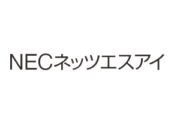
Lieu Japan
Secteur d'activité Telecommunications
Plateforme SharePoint 2010
Besoins critiques
- Construction of a platform for information sharing with easy usage for all end-users, regardless of their IT skills
- Enforcement of governance throughout the organization automatically, while sustaining the quality of SharePoint operational services
Senior Manager, Management Systems Division, NEC Networks & System Integration Corporation
Résultats
Why did you decide to implement SharePoint?
Mr. Masahiko Hirami, Senior Manager, Management Systems Division, NEC Networks & System Integration Corporation:
In 2008, we started contemplating implementing a shared information management system, due to the fact that we were maintaining more than 100 different file servers with no consistent management throughout. In 2011, we decided to implement Microsoft SharePoint 2010 as the main system for managing content for the whole organization. At the same time, we implemented and started to utilize AvePoint’s DocAve Software Platform to help the IT department manage site collections and the creation of sites.
System configuration diagram:
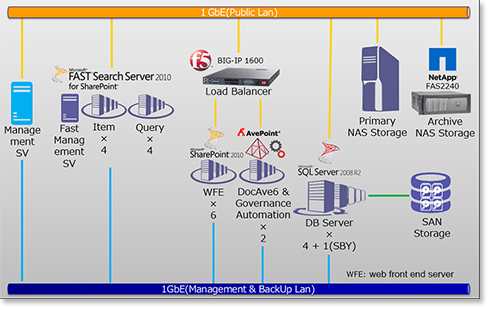
We understand your ICT director had a strong vision for SharePoint, which led you through the implementation process. What was his roadmap like, and what kind of business challenges did the company encounter?
Mr. Hirami:
First, the director wanted to ensure that the information sharing platform would be trouble-free and easy for end-users to operate. Second, he believed the platform should be automated and require minimal manual effort, ensuring the quality of operations while enforcing IT governance across the whole organization.
Why did you decide to develop a custom UI for SharePoint for your organization?
Mr. Hirami:
As an organization where hierarchy is very important, one of the most crucial requirements for our system was the ability to view the system’s overall structure in a hierarchical fashion. We needed to maintain this view even as the organizational structure changed. Additionally, we needed to ensure that end-users could easily navigate the system as easily as they could with the file system we used previously for information management. Therefore, we concluded that we needed to custom develop the SharePoint UI to fulfill these needs, which could not be met by SharePoint’s default settings.
Could you tell us the reason why you chose AvePoint Partner Services (APPS) to help you develop the custom UI?
Mr. Hirami:
At first, it was difficult for us to communicate exactly what we wanted to do in precise and accurate terms. However,AvePoint understood our situation and proved to be very helpful. After sharing about 30 or 40 issues we had with the SharePoint environment, AvePoint gave us a well-defined, clear-cut proposal which even included some issues we had not yet realized. After witnessing this kind of professionalism, selecting APPS as our service provider was easy. Even though we faced several issues when we were articulating what we actually wanted to do, AvePoint never said, "We can't do that.” Instead of rejecting ideas, they always brought us alternatives. Also, in the very early stages of our discussion, AvePoint spoke with our ICT director on several occasions. AvePoint made a proposal to him that defined requirements and presented mock-ups for the project plan. The APPS team came to our office once or twice per week to help us draft papers and proposals for the organization’s C-level members. AvePoint’s prompt, timely response to all of our requests was also impressive. When we asked them to make any changes within the documents in the morning, they would come back with updated versions that same afternoon.
What was most important to you when customizing the SharePoint UI?
Mr. Hirami:
Our aim was to design a UI which could be easily operated by everyone, including our end-users who possessed the least amount of technical knowledge.
Mr. Yasuyuki Aoki, Management Systems Division, NEC Networks & System Integration Corporation:
Our ICT director instructed us to make SharePoint’s advanced features as simple as possible. In order to achieve this, we paid extra attention to the platform’s details. For example, we placed buttons in appropriate places to make more complicated operations – such as right clicking – unnecessary. Additionally, we created two separate buttons for browsing and editing files in order to help simplify SharePoint’s check-in/check-out functionality. This way, end-users – such as C-level executives – who just want to browse a file can simply click the appropriate button and look at the file they want.
Mr. Hirami:
In order to keep SharePoint’s security settings intact, we set a rule that shows an authorization setting screen every time a worker registers a new file. On this screen, the end user who creates the file is asked to configure who can access it. We have taken this step and remained cautious of SharePoint’s security settings in order to avoid the risk of damaging our reputation or interrupting business continuity due to users accidentally leaking information to those who should not have access to it.
Examples of UI customizations:
| Group Notification Function | Show notifications about SharePoint operations and service information in the top left section of the screen in red text. |
| Search Contents Function | Users can refine searches using conditions such as Renewal Period, Area, File Type, Updated By, File Size, and more. The search results can show up to 1,000 items. If the number of results exceeds 1,000, the user receives an alert in red text that asks them to perform a more refined search. |
| Font Resize Function | Users can resize fonts on the screen. |
| Hierarchical Display | The first (department), second (section), and third levels are shown in the system’s tree structure. Folders are also color coded, creating an environment that is organized and easy to understand visually. |
| Document Management Functions | End-users can register favorite sites and access files they recently viewed or used conveniently from their My Site pages. |
| On their My Site pages, the users can see the site structure in a tree view on the left side of the screen while folders and files are displayed on the right side. | |
| Users can drag and drop documents and folders between SharePoint and their desktop, as well as between SharePoint environments. | |
| Users can cut, copy, paste, delete, edit properties, check-in/out, discard checkout, and edit version history for folders and documents. |
Examples of custom UI:
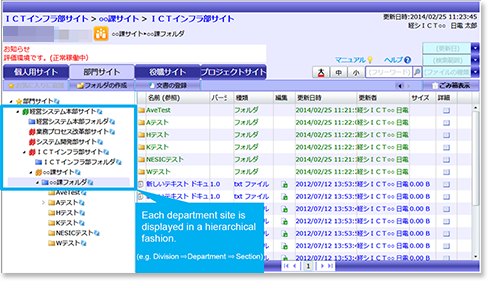
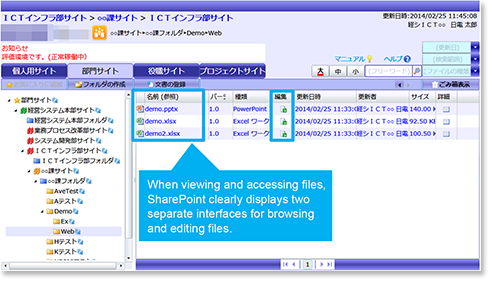
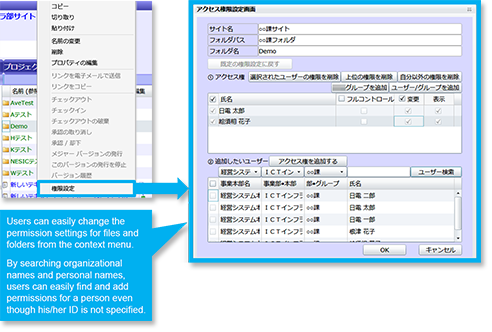
Can you tell us about how the process of the custom UI project went?
Mr. Hirami:
Our primary IT vendor and AvePoint Japan collaborated on this project. An engineer from AvePoint Japan, who was specially assigned to work solely on our project, led the project alongside with the IT vendor and sales representatives from AvePoint Japan. The engineer played the role of contact person on the Japan side, while members of the APPS team in other countries took part in the actual procedure, from UI development to release. Nine people from AvePoint – ranging from sales engineers to developers to quality assurance – aided us. We began the project December 2011 and worked on it for approximately six months, ultimately releasing to end-users in May 2012.
Mr. Aoki:
It was a challenge for us to understand the notion of "access permission inheritance," then to express what kind of hierarchical display we wanted to develop within this scheme. At one point, we needed to break permission inheritance on the upper level and configure special permissions, which resulted in the lower level not performing as intended. So, we talked with the AvePoint engineer about the issue late into the night, thinking through together what would happen if certain inheritance was cut on specific levels while writing down the possible outcomes on the white board to think it all through – it was a challenge at the time, but now it is a fond memory for us.
After the custom UI development, DocAve Governance Automation was also implemented in your SharePoint environment. Can you tell us how you reached that decision?
Mr. Hirami:
We were confronted by two big challenges after the deployment of SharePoint. First, we needed to migrate sites and content every time an organizational restructure occurs. Second, we needed to visualize and generate reports on the usage of the system storage.
Mr. Aoki:
We expected that approximately 8,000 end-users would access SharePoint, so we created 500 site collections for departments and 500 site collections for projects. At first, two members of our IT department were preparing to take on the task of creating the site collections without using special IT tools or software due in part to our budget. However, our ICT director objected, stating that "Human error is inevitable, and the IT department must ensure the quality of service is kept high by minimizing such errors." After that, we started to explore the possibility of implementing the solution to automate the service request process as much as possible.
Why did you choose DocAve Governance Automation as your solution for automating service requests from end-users?
Mr. Hirami:
First, we liked how it could automatically process requests from end-users – such as extra storage space requests – without the IT department getting involved, minimizing the possibility of human error. Also, we were impressed by the feature that enforces the rules set by the IT department during the process of request management, ensuring all actions within the system remain under control and in accordance with the organization’s governance policies. From the end-user perspective, DocAve Governance Automation’s real-time request process and its ability to provision new sites on-demand without waiting was tremendously appealing. With DocAve Governance Automation, department leaders can also generate reports on how much storage space each member of their team is utilizing, which leads to better cost management.
In terms of day-to-day SharePoint operations, what kind of IT services are automated through DocAve Governance Automation? Besides cost management, are there other outcomes you expect to achieve with the software?
Mr. Hirami:
Currently we are still in the preparatory stage of using the product, but we hope to create a service menu which can be used by end-users to request new project sites, extra storage space, reports on the usage of storage space, granting independent permissions defined by workflows, and more. We plan to implement DocAve Governance Automation in order to automate those processes. By implementing the software, we hope to see shortened lead time for delivering IT services, which is crucial for cost management. Before, it took a long time when site collection administrators requested a project site, because the IT department could not perform such tasks immediately. However, with the help of DocAve Governance Automation, we are able to create the sites in a timely manner, ultimately speeding up our business process.
Services offered by DocAve Governance Automation:
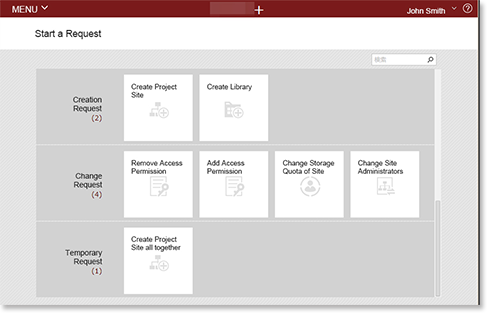
Moving forward, how do you plan to use AvePoint’s products?
Mr. Aoki:
Thanks to the customized UI, we now have a SharePoint environment with maneuverability that is similar to Windows Explorer, which is what we used before SharePoint. Because of this, we received very few inquiries about how to use SharePoint from end-users after the initial deployment. In the future, we would like to continue to utilize new features within DocAve Governance Automation, such as the software’s ability to automatically archive files.
How would you describe your overall experience working with AvePoint?
Mr. Hirami:
We have been impressed by how quickly AvePoint responds to us, as well as how easy proposals were to understand during the UI custom development phase. Also, we like the uniqueness of AvePoint's products. Even we – the people who run SharePoint on a daily basis – have learned a lot from these products and gained new perspective on the platform. We also appreciate AvePoint's ability to deal with incidents. AvePoint resolved an issue – which took another vendor 24 hours – in only four hours. It is great to see how quickly AvePoint can react to problems when something goes wrong.
Mr. Aoki:
We encountered an issue after the UI customization. The screen, which was supposed to appear after registering new document, failed to show up. However, a member of the APPS team, after looking into the system, found out that an unnecessary function was turned on, and managed to resolve the issue. I think it shows how well AvePoint knows SharePoint, even down to the smallest detail.
